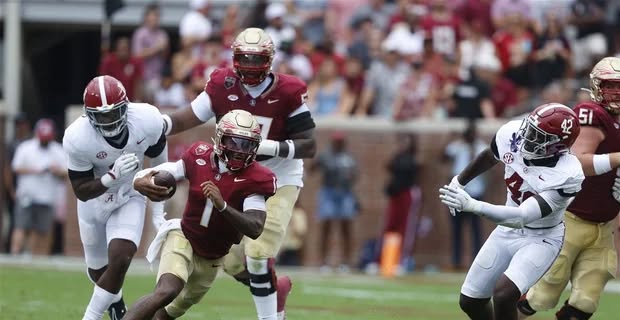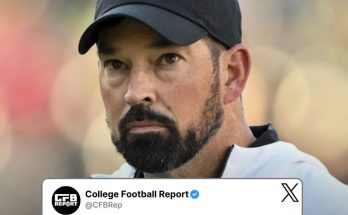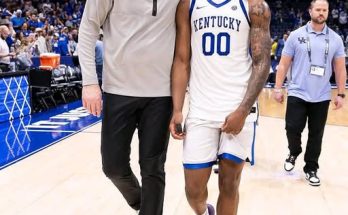Alabama football has always carried with it a certain aura, a mystique born out of decades of dominance and the recent dynasty under Nick Saban. It is a program synonymous with high expectations, unmatched consistency, and the kind of pressure that makes every single Saturday a referendum on the state of the Crimson Tide. That is why when Alabama opened the season against Florida State and fell 31-17, the conversation was not just about one loss but about what this result says regarding the current state of the program. Senior Bama247 writer Alex Scarborough offered his perspective on what changed for Alabama and, perhaps more tellingly, what hasn’t changed nearly enough. His take highlights that despite hopes of a rejuvenated direction, Alabama is still weighed down by many of the same issues that plagued them last season, and against a high-caliber opponent like Florida State, those flaws became too glaring to ignore.
At its core, the loss was not about effort or the team being outclassed physically. Alabama still looked like Alabama in terms of size, speed, and raw athleticism. The Crimson Tide had their moments on both sides of the ball that reminded fans why this team is never far from national title conversations. But football is a game of execution, detail, and adjustments, and in each of those categories, Alabama came up short. Scarborough’s observations pointed to an undeniable truth: while some offseason adjustments were made, including changes in staff and approach, the deeper, more pressing problems were not solved. The offensive inconsistency, the inability to dominate at the line of scrimmage against elite competition, and the lack of a quarterback who can elevate the team in critical situations all resurfaced in Tallahassee. For Alabama, that is the harsh reality—this is not the Alabama that has come to define the Saban era.
The offensive woes were particularly striking. Coming into this season, the Tide faithful were hoping that the quarterback position would stabilize and provide clarity. Instead, the game against Florida State proved that the uncertainty remains. The passing attack lacked rhythm, the deep shots were inconsistent, and the offense often looked stuck between two identities. On one hand, there was the traditional ground-and-pound approach that Alabama has leaned on historically. On the other, there was the need to modernize, to embrace tempo and dynamic passing schemes to keep up with explosive teams like the Seminoles. The result was a muddled identity, a play-calling approach that seemed cautious and reactive rather than confident and proactive. Florida State took advantage, forcing Alabama into predictable situations where the Tide’s offense stalled repeatedly. Scarborough pointed out that this wasn’t just about one game—it was about a continuation of offensive struggles that began last season and linger into this one, which signals a systemic problem rather than a temporary lapse.
Defensively, Alabama showed flashes of its old self but also faltered in ways that are uncharacteristic of a Saban-coached unit. For years, Alabama’s defense has been the gold standard of college football, known for suffocating front sevens and ball-hawking secondaries. But against Florida State, breakdowns in coverage and struggles to contain explosive plays told a different story. Florida State quarterback play was sharp, and Alabama had no consistent answer for their balanced attack. On third downs, which have traditionally been a hallmark of Alabama dominance, the Crimson Tide looked vulnerable, allowing Florida State to extend drives and sustain momentum. This inability to make key stops not only kept the defense on the field but also exposed the offense to more pressure as the game wore on. Scarborough noted that this is where Alabama must evolve; the defensive talent is present, but the cohesion, discipline, and situational execution are not at the level needed to win against top competition.
What makes this result sting for Alabama fans is not just the loss itself but the broader implications it carries. For years, Alabama set the standard of excellence in college football. They were the team that everyone measured themselves against. But in recent seasons, the cracks in that armor have become more evident. Georgia has risen to power, LSU has had moments of resurgence, and now Florida State looks like a program capable of entering that elite tier. Meanwhile, Alabama finds itself asking difficult questions. Are they still the same juggernaut they once were? Or has the rest of the college football landscape caught up—and in some cases surpassed them? Scarborough’s reflections pointed toward the uncomfortable reality that Alabama can no longer simply rely on talent and pedigree to win. The margin for error has shrunk, and the need for innovation has grown. Yet Alabama seems to be caught between eras, still leaning on what once worked but not fully embracing what is required to dominate in the present.
Another element that Scarborough emphasized was the psychological side of Alabama’s struggles. There was a time when teams feared Alabama in a way that went beyond just their physical presence. The intimidation factor was real. Opponents would step onto the field already mentally taxed, knowing they were likely in for a long, punishing afternoon. But against Florida State, that aura seemed diminished. The Seminoles played with confidence, aggression, and no hesitation. They looked like the team expecting to win, while Alabama at times appeared tentative. That shift in mentality is critical because it speaks to the changing narrative around the Tide. If opponents no longer view Alabama as untouchable, the psychological edge that once gave them such an advantage is gone. Reclaiming that edge is not about slogans or tradition—it is about proving on the field, through execution and dominance, that Alabama is still the standard. Right now, that proof is missing.
Special teams also played a role in the game’s outcome. Alabama has historically prided itself on being sound in all three phases of the game, but mistakes in this area compounded their problems against Florida State. Missed opportunities, poor field position, and miscues added pressure to an already struggling offense and defense. Scarborough highlighted that while these moments may not define a game on their own, in close contests against elite teams, they become the hidden factors that tip the scales. For a program that has built its legacy on attention to detail and minimizing errors, the slippage in special teams is symptomatic of a larger issue: the margin for error has evaporated, and Alabama is not playing clean enough football to overcome it.
So what changed for Alabama? The honest answer, as Scarborough put it, is not nearly enough. Coaching adjustments were supposed to spark growth, but the offensive identity crisis remains. Recruiting continues to bring in elite talent, but that talent is not translating into the kind of dominance Alabama fans have come to expect. The defense, while still loaded with playmakers, is no longer the impenetrable force it once was. The psychological intimidation that once defined the Tide has eroded. In short, the things that needed to change for Alabama to reclaim its perch atop the college football world haven’t materialized, and the things that were once their greatest strengths are no longer guarantees. Against Florida State, all of that was laid bare for the nation to see.
The loss does not mean Alabama’s season is over. The Crimson Tide remain one of the most talented teams in the country, and with Nick Saban at the helm, no one should count them out. The SEC schedule still offers plenty of opportunities to regroup, prove themselves, and potentially play their way back into the playoff picture. But what this game underscores is that Alabama’s path forward is not as simple as “getting back to what we do.” The sport has evolved, the competition has improved, and Alabama must evolve with it. Otherwise, nights like the one in Tallahassee will become less of an aberration and more of a trend. That is the reality Scarborough warned about, and it is one that Alabama must confront head-on if they hope to remain among the sport’s elite.
In the end, Alabama’s 31-17 loss to Florida State is not just a scoreline—it is a statement about where this program stands and where it needs to go. It is a reminder that the dynasty is not invincible, that dominance is not permanent, and that success in college football requires constant adaptation. For Alabama, the challenge is clear. What changed? Not nearly enough. What must change? Almost everything. The question is whether the Crimson Tide are willing to face that truth and do what is necessary to rise again, or if this marks the beginning of a new era where Alabama is no longer the team everyone else fears but just another great program fighting to keep up in a sport that has caught up to them.



